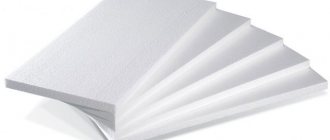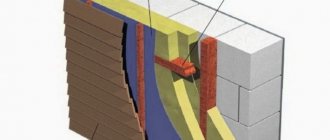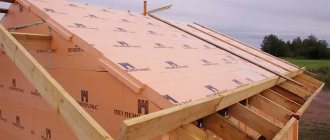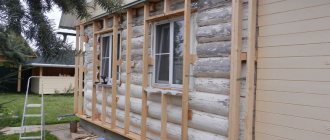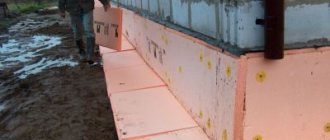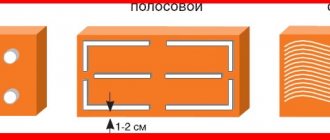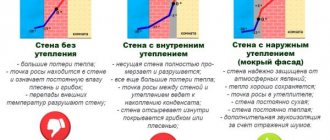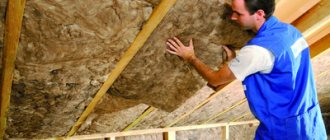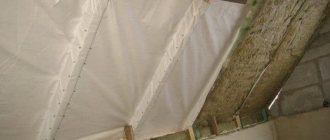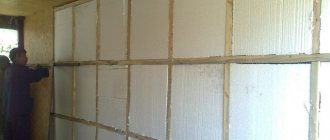Owners of private houses often have at their disposal separate basements where canned food and vegetables are stored. If the room is not properly equipped, then during severe frosts the walls of the structure may freeze. Frosts can also affect structural elements if there is high humidity, so the basement of the house is waterproofed from the inside, as well as building elements are finished with insulation. Let's consider how in practice the insulation of basement or cellar walls is carried out from the inside.
Insulate your cellar
We insulate the ceiling of the cellar
Before starting insulation work, we check the entire surface of the ceiling in the basement for cracks, potholes, etc. We carefully clean all these defects and seal them with a solution or carefully blow them out with foam. After this, we treat the entire surface of the ceiling with antifungal solutions (quicklime or copper sulfate).
There are a lot of options for insulating a basement ceiling in a garage - from polystyrene foam to reflective insulation.
The ceiling can be insulated with any of the materials described above; for insulation with mineral wool or glass wool, a special frame will be required, which is then sheathed with HA sheets, plastic, plywood, etc. Installation of polystyrene foam or expanded polystyrene can be carried out on parachutes with the preliminary application of a special solution, then the mesh is applied and plastered surface and painted, you can also use facing material (decorative tiles, panels, etc.). Decorative cladding material can also be used for reflective thermal insulation.
Recommendation! Before insulating the ceiling, all electrical wiring for lighting should be done, and the wires should be laid in non-flammable corrugation.
Cellar waterproofing measures
To significantly reduce the cost of thermal insulation measures, it is necessary to ensure reliable waterproofing of the structure during the construction of the cellar. The requirements for its waterproofing will depend on the depth of the cellar.
When preparing for the construction of a cellar on a site, it would be correct to inquire about the location of groundwater and the indicators of soil freezing on it.
If the groundwater level is low, you can get by by pouring a concrete floor, simply plastering the walls and then whitewashing them. For waterproofing, you can use ordinary roofing felt.
In cases where groundwater is located close to the surface, it is better that the plaster is applied both inside and outside the wall. In addition, the walls are coated with bitumen mastic and roofing felt is pressed against them. And to better fix it, an additional brick wall is erected, which is covered with a layer of clay of about twenty centimeters, thus creating an additional barrier to moisture.
When a storage facility is built on sandy soil with good drainage, the walls must be covered on the outside with bitumen mastic and immediately sprinkled with coarse sand.
Insulation of basement walls from the outside using materials from TechnoNIKOL
A large number of brands of insulation are offered by the famous Russian manufacturer of materials for facades and roofs, TechnoNIKOL. Among them is Carbon series polystyrene foam.
Note!
A distinctive feature of the brand is the presence of an L-shaped groove on the edge of the slab, which simplifies installation and eliminates cold bridges at the seams.
The slabs are installed on a pre-cleaned, prepared and waterproofed base using glue. Suitable compositions are Ceresit, Caparol.
Laying rules:
- The adhesive can be applied in a continuous mass, dotted or along the perimeter of the slab with two additional lines in the middle.
- The top row of PPS slabs is laid with joints spaced apart from the bottom row.
- After 24 hours, when the composition has completely hardened, the masonry should be reinforced with plastic dowels with wide plate-shaped caps at the rate of at least four pieces per PPS workpiece.
- Next, you need to lay a mesh with a cell size of up to 7 millimeters on a special reinforcing compound and cover it with the same compound.
- Finishing options: facade plaster + painting, tiled coating.
DIY basement insulation technology
Let's look at how complex basement insulation is carried out using penoplex (the technology will be similar for polystyrene foam and expanded polystyrene). Note that comprehensive thermal insulation includes external and internal insulation (in particular walls, floors, ceilings).
In addition to insulation for work you will need:
- material for interior decoration;
- polyurethane foam;
- reinforced polymer mesh;
- waterproofing material (bitumen mastic);
- adhesive solution;
- concrete or external plaster;
- tool.
In order for the insulation of the basement from the inside to be sufficient for the minimum level of heat loss, the thickness of the insulation should be:
- 10 centimeters for polystyrene foam;
- 8 centimeters for polyurethane foam.
But it is recommended to increase this value by 40 - 50% if the basement is supposed to be heated and maintain a temperature of 20 - 25 degrees in order to reach the recommended level of thermal insulation.
If water penetrates, then it is unacceptable to insulate from the inside.
Insulating the basement from the inside is a necessary measure when external insulation is impossible or not cost-effective. Internal insulation of the basement can only be carried out on dry foundation walls. But this poses a risk of increasing the rate of destruction of the foundation due to its freezing.
If water penetrates into the basement from the ground through the foundation walls, then laying insulation on the inner side surface of the foundation is strictly prohibited.
Internal insulation will cause even greater moisture in the foundation, and will also lower its temperature in winter, since there is no external insulation.
The freezing area inside the foundation will increase significantly, which, coupled with increased humidity, will very quickly damage the foundation.
How to drain and drain water
Eliminating water penetration into the basement from the ground is either difficult or impossible. More often it is necessary to install a drainage system around the house or repair the existing one.
In this case, it is necessary to tear off the foundation from the outside. In this case, talking about internal insulation loses all meaning, since the foundation walls become free for external insulation and for additional waterproofing.
There may be other drying options. Sometimes the issue is resolved comprehensively for a group of houses or an entire village, by opening a drainage ditch.
Sometimes the basement can only be drained by installing a well with a pump. Although pumping out a spring under a house is an extremely thankless task, what should you do? This source of water can serve the purpose of water supply to the house, so not all the work of the pump will be “wasted”.
Thus, for a wet basement there is only one method of insulation left - external with preliminary drying of the soil.
If finishing is required
In the basement, polystyrene foam does not require additional protection, since sunlight does not penetrate into the basement. Therefore, the layer you paste on the wall yourself does not need to be covered with additional protection.
If finishing is necessary, then the easiest way to insulate the basement from the inside is to do the following:
- coat the polystyrene foam with a thin layer of glue using an 8 mm notched trowel;
- drown a plaster fiberglass mesh with a cell size of 4 - 5 mm in glue;
- Apply another layer of glue on top of the mesh with a shaped roller, obtaining a shaped surface that is suitable for painting.
But this simple option can be replaced with any other finishing option, with the exception of heavy finishing (ceramic tiles, stucco...), and methods where it is necessary to break through the continuity of insulation. Most often, either figured plaster or leveling the wall under wallpaper is used.
Foundation insulation
In wooden houses, the foundation most often fulfills the purpose of the base, therefore it protrudes relative to the walls of the house. When the groundwater level is high, it is important to pay attention to the freezing of the soil around the base.
If during the construction stage the foundation was not insulated and waterproofed from the outside, you will have to dig a trench around it to bury the insulation sheets. To waterproof the underground around the house, you will additionally need to make blind areas.
From the outside, the foundation is insulated with cement bonded particle boards 15-20 mm thick or foam plastic. The slabs are attached to the foundation with special glue. Then the insulation is reinforced and plastered, or covered with decorative stone.
To drain water around the base, a blind area of asphalt or concrete is made. The blind areas are mounted at a slope towards the outside of the walls of the house. The presence of a blind area will additionally protect the foundation insulation from moisture penetration through it and subsequent destruction.
Laying a blind area made of expanded polystyrene, penoizol, or polystyrene under a concrete screed will create an additional heat-insulating layer for the underground and protect the foundation from the effects of temperature changes.
Which material to choose
Thermal conductivity coefficient of various insulation materials
The basement level is constantly exposed to lateral and vertical pressure, dampness, acids, insects and rodents. These factors must be taken into account when choosing insulation. There is a wide range of materials on sale, differing in price, performance characteristics and installation features. When making a choice, you should evaluate each product property.
Expanded clay
Expanded clay is balls or sharp porous granules obtained by vulcanization of natural clay. The material is more often used when constructing roofs in residential buildings and outbuildings.
Floor insulation scheme with expanded clay
The product has the following advantages:
- affordable price;
- low density;
- ease of use;
- environmental Safety;
- low thermal conductivity.
Styrofoam
Foam is easy to process and has high water resistance
Polystyrene foam is a time-tested material that is used in private and industrial construction, in preparing country houses and garages for winter.
Expanded polystyrene has the following advantages:
- excellent insulating properties;
- waterproof;
- low specific gravity;
- ease of processing and installation;
- small price.
Disadvantages include fragility and toxicity when burning.
Penoplex
Thanks to the spongy structure, penoplex is easy to cut
The decision to insulate the basement from the inside with penoplex will create high-quality and reliable protection of the room from dampness, temperature changes, insects and rodents.
Polymer material has the following advantages:
- dense structure, eliminating crumbling and breaking during installation;
- low thermal conductivity;
- almost zero hygroscopicity;
- long service life;
- environmental cleanliness;
- repellent effect on living beings;
- wide temperature range;
- resistance to alkalis and acids.
Minvata
Mineral wool is a good thermal insulator
The industry produces mineral wool from broken glass, steel slag and natural stone. The finished products are fibers randomly bonded in space. Mineral wool is produced in the form of mats and rolls, the thickness of which is 100-400 mm.
Advantages of the material:
- ease;
- low thermal conductivity;
- elasticity;
- flexibility;
- durability.
The disadvantage is its hygroscopicity and the release of many volatile particles harmful to health during installation.
How to choose the thickness of insulation?
To reduce heat loss and ensure an acceptable temperature in the premises when insulating, the thickness of the walls, their heat-insulating properties, type of foundation, climate of the area and prevailing wind loads are taken into account. If the walls are thick enough, made of materials with high heat-insulating properties (for example, made of brick or logs), insulating the facade is not necessary.
The thermal insulation of a house assembled from cinder blocks should be maximum - this material is not capable of retaining heat for a long time. When calculating the thickness of the walls, the thermal conductivity coefficient of the insulation itself is taken into account. The best characteristics are provided by materials such as polyurethane foam, polystyrene, and mineral wool.
For example, a 50 mm layer of polyurethane can retain heat in the same way as 1720 mm of brick.
Thermal conductivity of materials
Professional builders use quite complex formulas to calculate the thickness of insulation. When choosing a heat insulator for a private home, it is convenient to use online calculators. You only need to indicate your region of residence, the size of the building, the types of basement and attic floors, the thickness and material of the walls, and the type of roof.
Even with significant wall thickness, a small layer of insulation along the facade is still worth laying. After all, upon contact with cold air and temperature changes, cracks form on their surface over time, leading to premature destruction.
Veranda attached to the house - expanding the living space: projects, tips on how to create it yourself (200 original photo ideas)
How to insulate a ceiling in a cellar
To organize a favorable microclimate, you need to know how to insulate the ceiling correctly and so that new problems do not arise. Penetrating cold air forms condensation on the ceiling. Simply covering the cellar will solve this problem.
Insulation of the cellar ceiling, work plan:
- Inspect the basement from above. Take a close look at the surface for seams and cracks that may exist between the concrete slabs. To eliminate them, you need to lubricate the problem areas with putty with antiseptic additives. This will insulate the basement well.
- A special membrane is installed on the areas treated with putty. It promotes normal moisture release throughout the entire period of operation. The membrane is better than other similar material as it prevents the penetration of moisture from the outside. If you didn’t know how to insulate the cellar lid, then a membrane is the best option.
How to insulate a damp space? A better solution than vapor barrier would be to install sheathings on the sheathing. It is necessary to select a material that will show excellent performance even in a damp space. Any strong bars can act as hangers, but their installation takes a lot of time. Insulation of the cellar lid, both outside and inside, can be done using a galvanized profile, which is attached to hangers.
Spray polyurethane foam
The most modern and high-tech insulation option. The insulating layer is applied using a special sprayer and after application it hardens, forming a porous layer of material similar in characteristics to polystyrene. In addition, this type of insulation can be used both for internal insulation and for external work. This will help create an effective heat-insulating gasket in cases where the building is free-standing and the ceiling freezes.
The only disadvantages of this solution include the high cost of implementation and the fact that the technology of applying polyurethane will not allow you to insulate the ceiling in the cellar yourself, without the use of special equipment. If the cost of the work and the ability to do everything yourself is crucial for you, then it is better to insulate the ceiling in the cellar with penoplex or polystyrene - the layers of these insulators are simply glued to the desired surface with a special glue.
vote
Article rating
Is it necessary to insulate the basement?
From the description above, it becomes obvious that yes, it is better to insulate the basement. Let's give a few more arguments for those who doubt:
- effective use of usable area;
- the appearance of fungi and mold in the basement, which are a source of unpleasant odors and deterioration of the microclimate on the lower floor of the house, is excluded;
- the temperature in the insulated basement does not drop to below zero;
- insulating the basement in a house makes it possible to protect the foundation from dampness and deformation due to soil heaving;
- the rate of destruction of the building foundation is reduced;
- the consumption of electricity or gas for heating the house is reduced.
Note. If the basement is not insulated, according to GOST 9561-91 “Reinforced concrete floor slabs” it is necessary to insulate the floor that separates the floor of the first floor from the non-insulated area. The same requirement is specified in SNiP 2.08.01-85
For your information, the technology for insulating a cellar is similar, but has some differences.
Recommendations
Advice for developers from specialists with experience in the construction and operation of basements:
- For interior decoration, materials are used that are not afraid of dampness or have been treated against rotting.
- To go down to the basement you need to arrange a comfortable, non-steep staircase.
- It is recommended that the first floor floor be heated over the ceiling with full thermal insulation.
- It is advisable to insulate the blind area and drain surface water into a drainage ditch or perforated pipe.
A properly equipped basement will be a great place to relax Source mysticirelandusa.com
Thermal insulation of the basement
There are two ways to insulate a cellar: from inside the room and from outside. According to experts, the most effective is still external insulation. With this method of thermal insulation, the material is installed outdoors (outside the room), thereby preventing the walls from freezing.
Basement wall insulation scheme.
There is only one technology for external insulation of a cellar: you need to dig out the entire structure that forms the underground storage, and then carry out full waterproofing and insulation of the cellar walls. Of course, all existing water leaks must be repaired.
Of course, carrying out such work requires a lot of money. Just digging up the soil will take a lot of effort, money, and time. But the end result will be a complete insulation system for your cellar, which will have waterproofing properties. If you do something, do it for a long time. All temporary options will bring absolutely nothing but continuous waste of your money and time.
When insulating a cellar from the inside of a room, it should be taken into account that condensation will certainly appear at the joints of the insulating material and the wall, which will cause damage to any coating. Based on this, it is imperative to carry out thorough waterproofing on the entire plane of the walls. Also, when insulating the cellar from the inside of the room, it is necessary to use only such insulating material that perfectly tolerates moisture.
Today, the most reliable thermal insulation material for this type of room is extruded polystyrene foam. This is ordinary foam plastic that has been processed by extrusion. During this process, it turns into an unbending, dense and fairly rigid slab. She is not afraid of practically anything: neither cold nor dampness. Only exposure to ultraviolet (sun) rays is harmful to it. Therefore, polystyrene foam is the most ideal thermal insulator for basements and foundations.
Very important!
Main types of heat-insulating materials
The main types of heat-insulating materials are:
- polymer materials;
- fibrous materials.
Polymer materials
Polymer materials include polystyrene foam, polystyrene foam, penoplex and polyurethane foam.
The most suitable insulation is certainly sprayed polyurethane foam. It will perfectly fill all the cracks, in addition, it will not require additional hydro and vapor barrier. All that remains is to make a false wall on top of it and the work is completed.
When using polystyrene foam, penoplex or expanded polystyrene, you must first apply a waterproofing layer to the wall. This can be liquid rubber, tar, or waterproofing films.
On top of it, using special glue and dowels with fungi, sheets of insulation are tightly attached to each other. The gaps between the sheets are sealed with foam or sealant, in the case of expanded polystyrene. The thickness of the insulation layer is usually 10 cm, but it all depends on the specific situation.
After this, the outer side of the insulation is covered with an adhesive composition, onto which a reinforcing mesh is applied. Another layer of glue is applied to the mesh. After all layers have dried, you can begin finishing - grouting, priming and plastering.
Important: when insulating basement walls, it is not recommended to use polystyrene foam. But if you still choose it, you need to choose the most moisture-resistant and durable, for example, PSB-S-15 brand
Mineral wool and other types of fibrous materials
These types of insulation are categorically not recommended for insulating any premises from the inside. Due to the fact that the dew point when insulating from the inside is located on the inner surface of the wall, it will constantly condense moisture.
When moisture gets on any materials that have fibers in their structure, they lose their heat-insulating properties, and the entire insulation procedure becomes meaningless.
If you still have to insulate the basement with such materials, you must carefully protect them from the wall. This can be a double layer of waterproofing, or an air gap.
After installing the mineral wool, be sure to use a layer of vapor barrier so that the wool “breathes.” Then again there is an air gap and only then finishing with plasterboard or wooden panels.
Choosing insulation
We decided to insulate the cellar, but we don’t know how to do it, and most importantly, what material to use.
Let's look at how to insulate a cellar in a garage using modern materials that experts use to insulate basements:
- polystyrene foam or extruded polystyrene foam;
- mineral wool;
- “warm” plaster;
- glass wool;
- reflective thermal insulation.
Insulating a cellar in a garage with the materials described above allows you to achieve good thermal insulation properties and prevent the appearance of fungus in the room, but each material has its own advantages and disadvantages.
Extruded polystyrene foam or polystyrene foam
Advantages:
- simple installation;
- environmental friendliness;
- you can use extruded polystyrene foam for floor insulation;
- service life up to 40 years or more;
- excellent water resistance;
- low cost;
- perfectly tolerates sudden temperature changes.
Flaws:
- is flammable;
- does not allow air to pass through.
Helpful information! Extruded polystyrene foam differs from polystyrene foam in its increased density and strength. Thus, the thermal conductivity coefficient of extruded polystyrene foam will be higher than that of polystyrene foam with the same thickness of the material. In addition, only extruded polystyrene foam is used to insulate the floor covering.
| Characteristics | Expanded polystyrene PSB-30 | Foam plastic PSB-35 |
| Density (kg/m3) | 30−32 | 27−29 |
| Thermal conductivity coefficient (W/mK) | 0,032 | 0,038 |
| Compressive Strength (MPA) | 0,25 | 0,08 |
Important! When using polystyrene foam or extruded polystyrene foam as thermal insulation, it will be necessary to treat all surfaces with a primer before starting work and, upon completion, additionally plaster the walls using reinforced plaster, and make a screed of cement and sand on the floor
Mineral wool
Advantages:
- allows air to pass through, allowing the room to “breathe”;
- excellent sound insulation;
- excellent thermal insulation;
- affordable price;
- long service life of 30 years or more.
Flaws:
- an additional frame for installation is required;
- allows moisture to pass through;
- work is performed in special clothing and gloves.
Important! If mineral wool is chosen as insulation, then it will be necessary to additionally make a vapor barrier in the basement to prevent moisture absorption by the wool itself and deterioration of its thermal insulation properties
"Warm" plaster
Advantages:
- excellent thermal insulation;
- affordable price;
- excellent sound insulation.
Flaws:
- it is necessary to apply a thick layer for good thermal insulation;
- difficulty in installation.
Recommendation! It is optimal to use “warm” plaster to cover surfaces together with other thermal insulation materials in order to achieve good thermal insulation.
Glass wool
Advantages:
- low cost;
- good thermal insulation properties;
- good sound insulation properties.
Flaws:
- work is performed in special clothing and gloves;
- an additional frame for installation is required;
- allows moisture to pass through;
- If exposed to moisture, it may emit an unpleasant odor.
Important! If mineral wool is chosen as insulation, then it will be necessary to additionally make a vapor barrier in the basement to prevent moisture absorption by the wool itself and deterioration of its thermal insulation properties. In addition to the vapor barrier material, it is necessary to use film or foil to insulate glass wool
Reflective Thermal Insulation
Advantages:
- high thermal insulation properties;
- material thickness is only from 2 to 5 mm;
- simple installation;
- possibility to use facing material.
Flaws:
- price;
- possible heat loss
Important! Reflective thermal insulation is quite thin and, like a mirror, will reflect infrared heat when reflected. As a result, it is not efficient enough at convection or induction of reflected heat, which leads to heat loss.
Advantages and disadvantages
The work performed to improve cellars, as a rule, has a number of positive qualities, as well as some disadvantages:
- An optimal atmosphere for storing canned goods and vegetables will be constantly maintained inside the storage facility.
- You can protect the structure from freezing, which negatively affects the structural elements of the extension.
- Subsequently, it is possible to use the premises not only as storage, but also for other purposes.
- Thermal insulation will avoid periodic heating of the cellar space.
- After the insulation work is completed, there will be no increased humidity inside the storage facility.
- Thermal insulation will protect the storage from the penetration of rodents and other pests.
However, despite the positive aspects, there are also a number of disadvantages: the cost of comprehensive insulation is quite high, and a higher temperature will be regularly maintained inside the cellar. In addition, when performing cladding, the usable area inside the storage facility will be significantly reduced.
Important. Before proceeding with thermal protection of the basement, it is necessary to understand the feasibility, since if the structural elements do not freeze at excessively negative temperatures, then performing this work will be impractical.
Types of cellars for a private home
When deciding how to insulate a cellar from the inside or outside, the type of cellar is first taken into account:
Above ground cellar
Above ground cellar
A separate room with a depth of up to 0.5 m into the soil. It can be free-standing or wall-mounted (one of the walls of the cellar is the wall of an outbuilding or garage). From the point of view of insulation, this is the simplest option, because It is possible to insulate the walls and roof from the outside and inside.
Deep cellar (semi-underground)
Deep cellar
The lowest point of the building is located at a depth of no more than 1.5 m from the ground surface. In this case, in addition to insulation, you should also think about neutralizing the effects of groundwater and frost heaving of the soil.
Underground cellar (bulk)
Underground (bulk) cellar
It is distinguished by the location of the floor at a level of 2-3 meters underground. With proper waterproofing, this is the most advantageous cellar from the point of view of operation, which perfectly maintains above-zero temperatures, approximately constant, throughout the year.
Despite the differences in construction, the design of the cellar is not diverse.
Standard cellar design:
- walls - if the soil is dense - soil, if the soil is moving - brick or stone;
- there is no floor, or rather it is dirt;
- ceiling - reinforced concrete or wood.
Accordingly, the ceiling, walls, and floor are insulated. Those. all cellar surfaces through which heat loss is possible.
Differences between a cellar and a basement
A cellar is a place for storing vegetables, fruits, homemade products and other food supplies. The main advantage of the cellar is the preservation of a constant temperature throughout all seasons. Usually a cellar is associated with a hole in the ground, but in some cases it must be done on the surface.
A basement is a part of a building located below the first floor, completely or partially buried in the ground. The basement may contain various utility rooms, such as a garage, laundry room, storage room, home theater or gym.
Based on the definitions, the main differences between a cellar and a basement are as follows:
- Location. The cellar is an independent structure that can be located anywhere, including in the basement. The basement is an integral part of the building.
- Purpose. The cellar is used as storage for agricultural products, and the basement is multifunctional.
- Temperature conditions. For a cellar it should be constant between 0 and 5°C. There are no strict requirements for the temperature regime of the basement; it can be cold or heated, depending on what it is used for.
Ventilation device
The first stage of insulation is the installation of a ventilation system in the underground, which will ensure air circulation inside the room and prevent the formation of condensation on surfaces.
Underfloor ventilation consists of installing two pipes on different sides of the room. The optimal location of pipes is on the south and north sides of the house. The installation of pipes is carried out in accordance with the laws of physics, cold air tends downward, and after warming up it rises.
The supply pipe is located at a height of 20-30 centimeters from the basement floor, and the inlet pipe - 40 cm from the ground. The outer opening of the pipe is covered with a fine mesh - protection against rodents entering the basement.
The outlet pipe is placed 30 centimeters below the basement ceiling. And its upper end is brought out onto the roof of the house. The top of the pipe is covered with a protective cap. This arrangement of pipes will ensure optimal air movement in the underground and protect the room from mold.
Work order
First of all, it is necessary to ensure high-quality waterproofing of the insulating layer. This can be done either with the help of films or other rolled waterproofing materials, or with the help of special mastics. They are applied with a brush and cover all cracks well, and the effectiveness of such mastics is at the highest level.
After this, a vapor barrier layer is laid. The best vapor barrier performance is achieved by special films - membranes that prevent the penetration of moist air into the heat-saving layer.
Next, the insulation is installed. Typically, in such operating conditions, polystyrene foam is used. It is easy to glue, it is not to the taste of mice and other rodents, unlike the same polystyrene foam, and also has excellent heat-saving characteristics.
Mineral wool is also often used. It is convenient to use not rolls, but slabs of this material. They can also simply be glued to the surface of the ceiling. In addition, they have a dense structure, which is easier to finish on the outside, with an outer layer of finishing.
To install such a heat insulator, it may be necessary to build a frame. This design is especially relevant in basements, which are supposed to be used not only for storing potatoes, but also as one of the utility or living spaces that will be frequently visited.
On this basis, you can attach an external decorative covering, which will improve the aesthetic component of the room. And it will be much easier to install the insulation.
After the insulation material has been laid, you need to cover it from the outside with a layer of vapor barrier film. You can use glassine, but its characteristics in this room are worse and its service life is much shorter.
Any heat insulator will very quickly become unusable if high-quality ventilation is not installed in such a place. If ventilation windows are located at opposite ends of the room, as is traditionally done in basements, it is necessary to provide for the possibility of closing these windows during the cold season.
In summer, and in other months with positive air temperatures, it is necessary to open the ventilation holes either completely or by a small amount.
If natural ventilation is not enough and condensation continues to form, it is necessary to build a forced ventilation system, which will include both supply and exhaust ventilation.
Insulation of cellar walls from the inside
Cellar floor insulation scheme.
Now you need to insulate the cellar from the inside. Getting started involves choosing insulation. Foam plastic has proven itself well.
It has a number of advantages:
- not damaged by moisture;
- strong enough, does not crumble;
- does not rot;
- does not need to be isolated from water by film devices;
- easy to install;
- has little weight.
The disadvantages of polystyrene foam are its high flammability and the fact that it is damaged by rodents. It is better not to lay it near electrical wiring.
Insulation of walls with foam plastic is carried out in several stages:
- treating walls with foam or sealing with sealants;
- smoothing out irregularities;
- insulating the surface from moisture using liquid rubber;
- insulation with foam plastic (work on insulating walls with foam plastic begins from their lower part, the plates are joined and glued, the cracks are treated with foam, the insulation is fixed with dowels);
- strengthening the mounting mesh and plastering.
The ceiling and ground floor also require a number of works on arrangement and insulation. The fact is that the reinforced concrete floor slab that serves as the roof can allow rain and melt water to pass through cracks, does not protect against the cold, and overheats greatly in the summer, which is unacceptable for storing food.
https://www.youtube.com/watch?v=6mInDEJmkrs
Range of thermal insulators
The range of heat-insulating materials sold on the market today is quite wide.
Let's consider only the main ones:
Foam plastic (cellular plastic)
Inexpensive material made from foamed plastic (mainly polystyrene). The excellent thermal insulation properties of polystyrene foam are explained by the presence of multiple individual granule cells, separated by partitions and filled with gas. An 8 cm thick slab is equivalent in thermal protection to 25 cm of wood or a 1.5 m brick wall.
Polystyrene foam is lightweight, easy to cut, and easy to install. Plates made from it are quite elastic and, unlike rolled materials, do not sag over time.
External foam insulation
The density and strength of polystyrene foam depend on the technology of its processing and the type of raw materials. For façade cladding, it is better to use high-density material - it crumbles less when cutting and has a longer service life.
Despite the fact that the foam itself does not rot, colonies of microorganisms can easily attach to its rough surface and can spread to other structural elements.
Due to its tendency to ignite, as well as the ability to be destroyed under the influence of sunlight, this insulation must be covered with a layer of plaster or used in ventilated facades.
Extruded polystyrene foam
Despite the fact that expanded polystyrene, like polystyrene foam, is made on the basis of polystyrene, its technical characteristics differ significantly. If foam foaming occurs under the influence of steam, then in polystyrene bulk granules are obtained by introducing a foaming reagent and then pressing it through an extruder. As a result, the material acquires a more uniform structure and strength.
All of its air granules are closed and have the same size, which is why polystyrene foam is less fragile than polystyrene foam.
Foundation insulation with polystyrene foam
The service life of this material is up to 40 years. It has minimal water absorption (up to 0.4%) and lower thermal conductivity - on average it is 0.029-0.034 W/(m K). The thermal insulation properties of polystyrene foam are very high - even a thin sheet is enough to create a reliable barrier to the cold.
But still, polystyrene foam is not able to “breathe”; it is better not to use it for wall decoration, otherwise they will get wet. The main purpose of expanded polystyrene is thermal insulation of plinths and foundation blind areas. A special high-strength, high-density material is used in construction as auxiliary or even load-bearing structures.
How to make a children's house with your own hands: from wood and other materials. Drawings with dimensions | (80 Photo Ideas & Videos)
Insulation and ventilation of the basement
Insulation technology can vary significantly depending on the type of basement structure. If there is an above-ground structure, the main emphasis should be on installing insulation inside and outside the structure. Foam plastic is best suited for such tasks. The technology for installing these materials involves carrying out all work outdoors.
Basement insulation, stages of work:
- Check the walls for damage.
- Remove all unnecessary items from the basement.
- Cleaning the hatch.
- Removing all detected defects.
- Basement waterproofing.
- Fixing rigid insulation boards.
- Attach a polymer mesh to the surface.
- Blow foam over the joints of the sheets.
- Apply plaster.
What is the best way to insulate a subfloor?
Insulation is selected depending on the behavior of the basement at different times of the year.
The choice of material is also influenced by the following factors:
- Indoor humidity level;
- Availability of heating;
- Availability of drainage around the building;
- Purpose of the underground.
Construction stores offer thermal and waterproofing materials with various characteristics. The following are popular and available:
- Styrofoam. The cheapest insulation. It is distinguished by its lightness, resistance to rotting, moisture resistance, and low price. The combination of these qualities makes foam plastic the most popular material for insulating wooden houses. The disadvantage of polystyrene foam is that it attracts rodents, is fragile, is highly flammable and releases harmful chemical compounds into the atmosphere.
- Expanded polystyrene. A substitute for polystyrene foam, which is more durable and has a tongue-and-groove system for a seamless connection. The material is often used to insulate basements from the outside and inside.
- Polyurethane foam. A sprayed material that fills all cracks when applied to surfaces. Creates a completely sealed coating, does not burn, does not rot. Disadvantages of the material: high price and the impossibility of self-application without special equipment.
- Penofol. Flexible insulation. Provides decent thermal insulation. Fireproof and waterproof.
- Minvata. Soft insulation, suitable for use only inside absolutely dry rooms. Under the influence of moisture, mineral wool begins to rot and gradually decomposes.
- Expanded clay. The use of this bulk material is only possible for insulating the floor and protecting the foundation from the outside.
Options for insulation materials and their characteristics
There are several types of basement insulation, each of which has its own characteristics.
Styrofoam
One easy way to insulate the inside of a basement wall is with foam insulation that is glued or attached directly to the concrete.
Advantages of the material:
- moisture resistance;
- does not rot, is not affected by fungus;
- not expensive;
- creates a vapor barrier;
- easy to install and cut;
- does not add load to structures.
Disadvantages of polystyrene foam:
- fragility;
- instability to fire, release of toxins when ignited;
- rodent damage.
Expanded polystyrene
Similar in characteristics to foam plastic, but does not have fragility. The material is not attractive to mice. Just like foam plastic, it requires a flat surface for installation and forms so-called “cold bridges” - cracks between the joints. They require additional sealing with polyurethane foam. The material is much more expensive than foam.
Expanded polystyrene - material for basement insulationRigid polystyrene foam panels will create a barrier on the basement walls that will hold back water and condensation that could otherwise accumulate in the basement, contributing to higher humidity levels and mold growth.
Polyurethane foam
Insulating basements with polyurethane foam is the most modern method. The material is applied by spraying. Distributing directly onto concrete walls, it provides uniform and complete thermal insulation. The foam should be covered with drywall for fire protection.
Advantages:
- sticks to all substrates (steel, concrete, wood);
- since it adheres perfectly to substrates, it can be used to continuously seal structures without creating any joints (a major advantage over polystyrene);
- serves as an air barrier;
- serves as a vapor barrier;
- resistant to temperature changes;
- does not rot;
- durable;
- quickly applied.
The disadvantage of application is the need to use a high-pressure installation, which precludes self-application. Hiring specialists is an expensive undertaking.
Mineral wool
Mineral wool is a traditional insulation material with proven effectiveness.
Pros:
- Mineral wool is inexpensive compared to other materials for basement insulation.
- Easy to install yourself.
- High thermal insulation properties.
Minuses:
- The material in the basement is susceptible to mold.
- Mineral wool is permeable, which does not prevent the contact of moist indoor air with structures. This may cause moisture condensation.
- If the integrity of mineral wool is compromised, it releases harmful particles that can get on the skin and into the respiratory tract.
Mineral wool - material for basement insulation
The material can become saturated with moisture from flooding the foundation, water flowing through the walls, and even from water vapor passing through the pores of the concrete. Wet mineral wool loses much of its core value and as it gets heavier it sag, leaving gaps in the insulation. Over time, a damp coating will encourage the growth of mold and mildew. The risk of moisture problems is reduced if the concrete is first covered with a solid layer of rigid foam. It is better to use mineral wool to insulate dry basements.
Expanded clay
The material has a narrow scope of application - it is used only for floor insulation. Has high moisture-absorbing and heat-insulating properties. This is a simple and effective remedy, economical in cost.
Internal or external insulation
Experts recommend approaching the issue of thermal insulation comprehensively, finishing the cellar from the inside and from the street side. Each method has its pros and cons, which should not be neglected.
External insulation allows you to protect the load-bearing structures of the building from dampness and temperature changes. Thanks to this, they continue to maintain strength and integrity. At the same time, there is no need to save space, since extra centimeters do not play a big role in the scale of the area of the site. External finishing takes on the pressure of the soil, preventing deformation of the walls and base.
The decision to insulate the cellar from the inside against freezing is made in cases where, for some reason, it is not possible to do this from the outside. When choosing the type of insulation, you should give preference to environmentally friendly materials with no odor and no release of small particles into the air. To neutralize the effects of dampness, you will need to sacrifice internal space. It is necessary to install a thick layer of insulation, which must be resistant to dampness and fungus.
To prevent the development of mold, you need to grind bleach into a fine dust and add it to the primer that will be used to treat the surfaces. This is a good way to disinfect load-bearing structures.
Ventilation and waterproofing layer
Insulating the basement of a private house requires the provision of high-quality waterproofing and ventilation. They help prevent premature wear of almost any insulation.
Waterproofing
There are many methods and materials for waterproofing a basement from the inside. The simplest and most reliable is surface treatment with liquid rubber. This is a water-based polymer-bitumen mass. The material is quite easily applied to the surface in any way: brush, roller or spatula.
Before starting work, it is necessary to ensure good ventilation of the room. Then a primer is applied to the entire surface, which is usually sold complete with bitumen paste. The mastic is mixed with a construction mixer and applied to the walls, floor and ceiling in any convenient way.
After drying, a homogeneous rubber layer is obtained. Despite the fact that the adhesion of waterproofing to the surface is very strong, it is necessary to additionally press it against the walls and floor so that even after several years, leaking water cannot tear off the rubber layer. To do this, a screed is made on the floor, and the walls are plastered, lined with brick or tile.
Ventilation
One of the simplest ways to ensure cellar ventilation is to install special vents in the foundation or two supply and exhaust ducts made of PVC pipes with a diameter of 1 to 5 centimeters. The operation of such a system is based on the temperature difference between the air coming from the street and the basement air.
Drainage
Additional protection is provided by drainage channels dug around the foundation, forming a single system. A drainage ditch is dug outside the building, and its depth is 0.2–0.3 meters. Next, geofabric is laid and crushed stone is backfilled. After laying the drainage pipe, cover it with geotextiles and fill it with sand or carefully compacted soil. The arrangement of a drainage system is necessary when the groundwater level is high.
Features of the cellar microclimate
Regardless of whether the cellar was located under a private house or built separately (like Angela Olegovna’s), in my opinion, it requires good insulation. This operation affects not only the formation of an acceptable microclimate inside, but also the service life of the building.
The walls in an improperly insulated cellar will become moldy.
If certain measures are not taken, the walls will quickly become unusable and collapse from the destructive effects of external factors: high humidity and significant temperature fluctuations.
But the most important thing is the optimal temperature for storing food. My auntie told me that soaked apples are obtained only if the air is not heated above 4 degrees Celsius and not cooled below 2. This can only be achieved if the cellar is thermally insulated both inside and out.
If the temperature in the cellar is too low or high, the products will deteriorate.
In this case, the walls of the cellar will not let warm air inside in summer and cold winter.
Another important point that many people rarely pay attention to. Many times I have encountered situations where moisture condenses on the walls and ceiling inside the cellar. This is one of the consequences of improper insulation (or its complete absence).
To reduce humidity levels, insulation measures are not enough. It is also necessary to design ventilation that will regulate the content of water vapor in the room.
And, of course, I advise you to immediately think about waterproofing, without which the thermal insulation material will get wet and work worse, and the walls themselves will quickly collapse.
However, let's return to our sheep. Before describing the process of insulating a cellar, I want to devote a few lines to the problem of choosing a suitable material.
